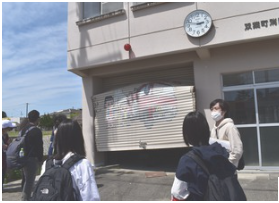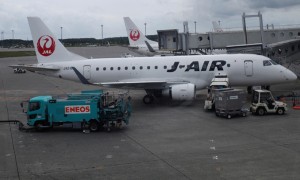FUKUSHIMA, Japan (Kyodo) -- In the more than a decade since reactors at the Fukushima Daiichi nuclear power plant exploded, the nearby town of Futaba has tried to pick up the pieces of a community shattered by the disaster.
Now, young people from other parts of Japan and elsewhere are playing a part in resurrecting a community to which they have few links.
Since last year, Tohoku University undergraduate student Masayuki Kobayashi has teamed up with his Indian schoolmates and a Futaba-based association to rehabilitate the Fukushima Prefecture town's tarnished image.

They are expanding their network to involve people of various nationalities, ages and skills, many young and without any direct links to the disaster-hit area in Japan's northeast. They aspire to attract tourists and develop sustainable homegrown businesses.
Soon, Futaba may again be inhabited, with an evacuation order for the reconstruction and revitalization base in the town expected to be lifted possibly as soon as July. But challenges abound.
"The town was said to be impossible to recover but if we can achieve that goal we can say to the world that nothing is impossible," said 22-year-old Kobayashi, whose involvement in Futaba started from a local walking tour he joined last year.
Joining Kobayashi in the cause are Trishit Banerjee, 24, and Swastika Harsh Jajoo, 25, who are PhD students at the same university in Sendai, Miyagi Prefecture. All three are interns for the Futaba County Regional Tourism Research Association.
With Futabaseeing an exodus of its residents, estimated at around 7,000 before the March 11, 2011, earthquake-tsunami and nuclear disasters, Kobayashi is determined to change perceptions of the town.
"If we can make more fun activities, then a more diverse range of people will visit," said Kobayashi whose brainchild, the PaletteCamp, is tailored toward that goal.
The idea of the camp is to have people interact with the local community through visits centered on Futaba and nearby areas, using fun activities like yoga to learn about the local culture and history, in a shift from the disaster-centric tours.
The PaletteCamp has been held three times since October last year, the most recent in May.
Ainun Jariyah, a 21-year-old Indonesian making her first trip to Futaba, was among around 15 participants in the latest program that included a bingo quest game in Namie, next to Futaba, to introduce the town's local culture and history, and a walking tour in English and Japanese in Futaba.
The group was struck by the contrast seen on the streets of Futaba with decrepit houses and empty lots juxtaposed by walls bearing refreshingly uplifting art.
"I learned that art could be used for peacebuilding and reconciliation and empower people," Jariyah said.
Jajoo, who provided English translation to Jariyah and a few others, could not be happier to hear such feedback. She wants camp participants to enjoy the fun elements "without imposing" the educational aspect.
Tatsuhiro Yamane, head of the association that supports the three in their project and guided Kobayashi on his walking tour, said, if the social infrastructure is in place, we can encourage more people to return or live in the area.
Yamane, 36, also stressed the importance of having thriving small businesses that are deeply rooted in the community while seeing the potential of tourism in a town that has long relied on the nuclear power plant for sustenance.
Yamane, a former Tokyo resident who eventually became deeply involved in Futaba after his post-reconstruction role there, is now a town assemblyman. He said progress in both hard and soft infrastructure is crucial.
"We must be able to build many things at the same time. It won't do to just construct a building," he said. "The key is to create a community that can make use of that structure."
Jariyah and her fellow participants may have wrapped up their PaletteCamp tour, which ended with a brainstorming session on how to develop Futaba, but their connection to Futaba did not end there.
They kept in touch online and are now exploring a project to make cookies with the Futaba "daruma" (Japanese doll) design, which is the town's symbol, eventually to sell them as a souvenir. The group has also been publishing newsletters, both in Japanese and English and in print and online, to introduce stories of day-to-day life in Futaba.
Banerjee believes their work to help in rebuilding Futaba is something "which most towns in the world do not get an opportunity to do."
"We are able to create a story that here is a town and here is something you can do against the impossible and we can do it together," he said.
While the three students visit Futaba from time to time from Sendai, former resident and musician Yoshiaki Okawa keeps alive the memory of his hometown through his performances across the country.
Okawa, 26, was fresh out of his junior high graduation ceremony when disaster struck in 2011. His family had to evacuate and they settled in Saitama Prefecture north of Tokyo, where he attended senior high and fell in love with the "koto," a traditional Japanese string instrument akin to a zither.
"Back then, I didn't want people to know that I had evacuated from Fukushima. I was still in pain and I did not want to talk about what I felt. I wanted to lay low."
During his performances, he often talks about his love for Futaba and its idyllic setting and how the place has inspired his music. Some of his compositions are a tribute to those impacted by the 2011 catastrophe.
Okawa hopes his music will encourage people who are still in pain and struggling from 2011 "to move forward."
His home in Futaba was torn down after their family decided not to return. Even so, he said, through his music, "I would like to help in mending the hearts of people. I feel I can do that even if I am not there."







